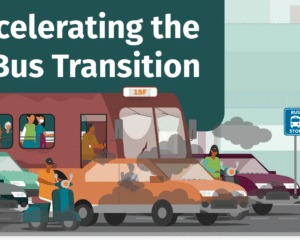Heads turned and the country watched as Nitin Gadkari, Union Minister for Road Transport and Highways, arrived at Parliament on 30 March, in the country’s first hydrogen fuel-based car. With aspirations to become a self-reliant country, he spoke on the need to produce hydrogen-based fuel in India. The unfortunate hostile conditions and sanctions against Russia have curtailed the global supply of crude oil – India imports 85 percent of its crude oil1, worth Rs 8 lakh crore. The cascading effect of this is the need to speed up investments in alternative sources of energy to offset the ever-increasing fuel prices and to meet India’s COP26 commitments. So, is hydrogen that alternate?
Let’s first break down the anatomy of a hydrogen-fuelled vehicle. A hydrogen vehicle has a hydrogen tank that feeds a fuel cell which provides energy, when mixed with oxygen, to power an electric motor. Basically, it has the characteristics of an electric car (because of the electric motor) and a conventional petrol car (as it has a tank). The fuel cell is what turns hydrogen gas into electricity that powers the electric motor and gives it that energy to move. Thus, there are no toxic tailpipe emissions and the only by-product of this process is water and heat. So what’s the catch here?
Firstly, research shows that hydrogen technology, its infrastructure, and supply, are still years behind electric vehicles (EV). In 2021, India reported a total of 1,640 operational public EV chargers in just about 9 cities2. What India needs is 400,000 charging stations to meet the requirement for two million EVs by 2026! Now that we are merely four years away from meeting our goal, the government has undertaken initiatives to fast-track the manufacturing and adoption of electric vehicles in India but the process has been slow. We are still trying to fit the EV puzzle together; are we ready to take on hydrogen?
Secondly, producing hydrogen gas is not as simple as one would imagine, albeit it being the most common element in the universe. If we wish to use hydrogen as fuel, it needs to be produced using other compounds such as water, natural gas, and other fossil fuels3 – this is when its environmental impact starts to become a concern. The Green Hydrogen Policy that was unveiled in India in 2022 gave a green signal to renewable energy plants to produce this fuel – but it can only be considered ‘green’ if the renewable energy source that produces hydrogen is also green. That is not the case in India. In short, the process of steam-reforming through which hydrogen is produced leaves behind carbon monoxide and carbon dioxide as by-products that contribute to atmospheric carbon.
And lastly, let’s address the elephant in the room – the cost factor. India is aiming to produce 5 million tonnes of ‘green hydrogen’ by 2030. The industry giants such as Adani Enterprises and Reliance have already drawn up plans to invest in manufacturing hydrogen fuel cells. But, for now, the uptake of hydrogen in the transport sector is minimal because of the lack of a distribution system and the cost attached to it. Hydrogen is highly flammable and for it to reach vehicles, it needs to be transported safely.
Existing natural gas pipelines aren’t suited for this purpose. Technology and innovations can bring costs down – a report by the International Council on Clean Transportation indicated that costs of green hydrogen can decrease to Rs 340 per kg by 2050, which currently costs a whopping Rs 500 – 1000 per kg.
Despite hydrogen being a promising alternative fuel solution, there are several challenges to its adoption in the near future. It will take years for the technology to become affordable enough to reach the masses. It took Delhi 7-8 years to completely shift to CNG (including the infrastructure) – a fuel that was readily available; hydrogen fuel is still at its innovation stage. However, India carved out a path to march along with its peers in the developed world to achieve climate goals – its COP26 commitments are commendable. And with an eye toward meeting these commitments, India can focus on electrification and a shift to more affordable, sustainable modes of transport.
Written by Kashmira Dubash,
Senior Programme Manager – Communications, Development, and Partnerships.
Recent Blogs

Connecting the Dots of Delhi’s Public Transport System
Find how the intricate network of Delhi’s public transport system and its ongoing efforts enhance connectivity, improve accessibility, and provide a seamless travel experience for millions of commuters in the bustling metropolis.”
Pune, Coimbatore and Chennai Selected as India’s ‘Smart Cities’
Pune, Coimbatore, and Chennai emerge as India’s Smart Cities, paving the way for sustainable urban development and innovative solutions. Explore their strategies and initiatives towards building smart and livable cities for the future.

She Cycles for Change
Join us on a journey with inspiring women who are cycling for change. Discover their stories of empowerment, resilience, and how they are transforming cities by advocating for cycling as a sustainable mode of transport.

Chennai’s journey to reclaim city streets for its people
Chennai’s remarkable journey towards reclaiming city streets for its people. Uncover the inspiring initiatives and transformative efforts that are reshaping the urban landscape and prioritizing people-centered mobility.

Challenges of a Bus-Rapid-Transit System in Indian Cities: The Rainbow case study
Learn from the Rainbow case study to understand the key considerations and solutions for building efficient and sustainable urban transportation systems.



